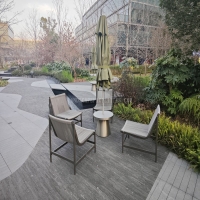Welcome to the website for landscape facilities products and knowledge.
What are the best materials for landscape tables in areas with high air pollution?
When selecting materials for landscape tables in areas with high air pollution, durability and resistance to environmental stressors are paramount. Air pollution, combined with weather conditions, can accelerate wear and tear, making material choice critical for longevity. Here are the top materials suited for such environments:
1. Powder-Coated Aluminum: Lightweight yet robust, powder-coated aluminum resists corrosion and pollutants. The coating provides an extra layer of protection against acidic rain and airborne chemicals.
2. Stainless Steel: Known for its rust-resistant properties, stainless steel (especially grades like 304 or 316) withstands pollution and moisture. Its sleek appearance also suits modern landscapes.
3. Recycled Plastic (HDPE): High-density polyethylene is impervious to moisture, chemicals, and UV rays. It’s eco-friendly, requires no maintenance, and won’t degrade in polluted air.
4. Teak Wood: Naturally resistant to rot and insects, teak’s high oil content helps it repel pollutants. Regular sealing enhances its durability in harsh conditions.
5. Concrete with Sealant: Sealed concrete tables are heavy-duty and immune to pollution damage. The sealant prevents staining and erosion from acidic particles.
For optimal performance, prioritize materials with low porosity and high resistance to oxidation. Regular cleaning and occasional protective treatments (e.g., sealants for wood or metal) further extend lifespan. Choose designs that minimize crevices where pollutants can accumulate, ensuring easier maintenance and sustained aesthetics in polluted urban settings.
By investing in these materials, your landscape tables will remain functional and visually appealing despite challenging environmental conditions.
Related search:

Recommendation
Metal structure rattan chair without armrests for single person, with woven seat and backrest.